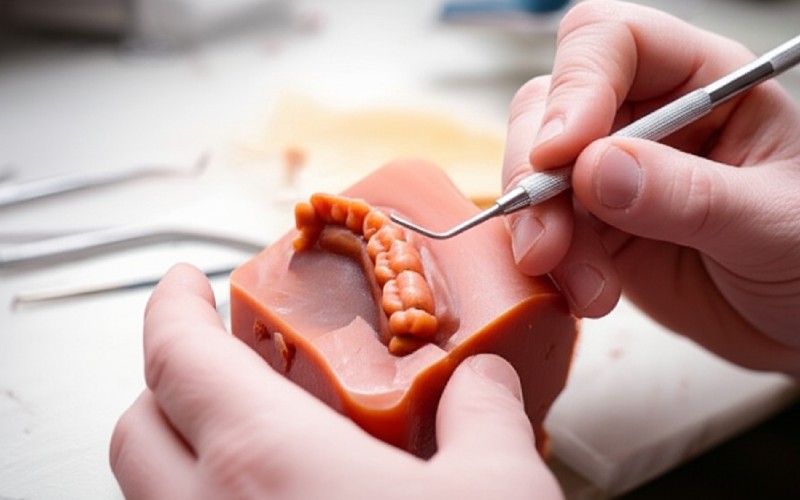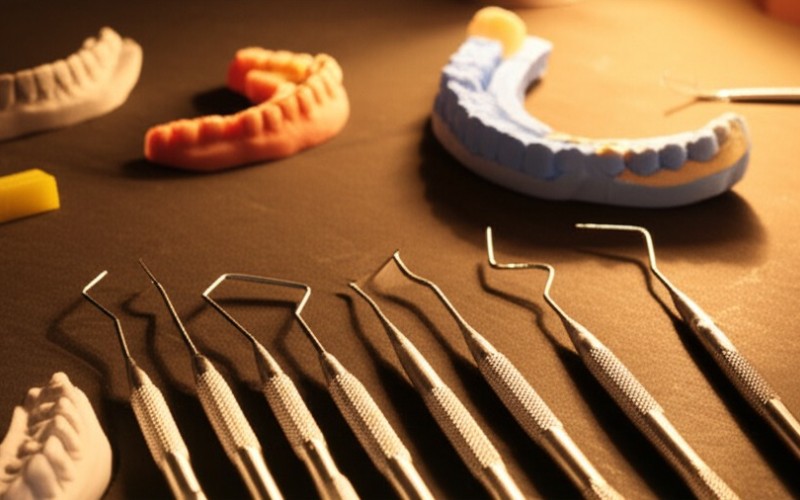
Dental Waxes Guide: All You Need to Know
Table of Contents
What Are Dental Waxes?
Dental waxes are soft tools that help make teeth things. They can be shaped when warm. They get hard when cool. Dentists use them to make teeth parts before the real ones go in your mouth.
Waxes help make:
- Fake teeth
- Crowns
- Tooth fixes
- Bite marks
The best waxes can be shaped well. They do not shrink too much. They must work in the mouth heat.
Types of Dental Waxes
There are many kinds of dental wax. Each one has a job to do.
Pattern Waxes
These waxes help make the shape for new teeth parts.
- Inlay casting wax:
- Makes crowns
- Makes bridges
- Helps fix teeth
- Melts at 38-60°C
If you need help with inlays for teeth, visit our guide.
- Baseplate wax:
- Comes in flat sheets (7.60×15.00×0.13cm)
- Used for denture frames
- Gets soft at 45-50°C
- Most used type (70% of all denture work)

Processing Waxes
These waxes help join parts or block areas.
- Sticky wax:
- Holds broken parts
- Used for soldering
- Has 0.5-1.2 MPa strength
- Must be used at right heat
- Boxing/Utility wax:
- Makes trays
- Seals molds
- Blocks out spots
- Comes in sticks or strips
Bite Registration Waxes
These help see how teeth fit together.
- Records bite marks
- Shows jaw position
- Must be stiff when cool
- Used with an articulator tool
How to Pick the Right Dental Wax
You need to think about some things when picking a wax.
What Will You Use It For?
- Fixed parts: Use inlay wax for crowns and metal inlays
- Removable parts: Use baseplate wax for dentures
- Joining parts: Use sticky wax
- Bite marks: Use bite wax
Heat Where You Work
- Hot rooms: Need wax that stays firm longer
- Cold rooms: Need wax that gets soft at lower heat
- High humidity: Need wax with less flow at 37°C
How It Acts With Heat
- Melting range: When it gets soft and hard
- Flow rate: How fast it moves when warm
- Shrinkage: How much smaller it gets (causes 15-20% of casting problems)
Good Brands to Try
- GC America
- Kerr LabWax
- Cavex

How to Use Dental Waxes: Step by Step
Let me show you how to use these waxes the right way.
Getting the Model Ready
- Make sure your stone model is clean
- Put a thin coat on the model if needed
- Check that the wax will stick to it
Carving Methods
- Heat your tools: Use a Bunsen burner or wax pen
- Add wax bit by bit: Don’t put too much at once
- Smooth edges: Use warm tools to make it nice
- Check the fit: Make sure it will work in the mouth
For better results with inlays made from eMax, good wax patterns are key.
Direct vs. Indirect Ways
Two main ways to work with wax:
Direct:
- Work right on the model
- Faster but less exact
- Good for simple shapes
Indirect:
- Make a mold first, then fill with wax
- More steps but better fit
- Less shrinkage (15-20% less casting problems)
Adding Sprues and Investment
When making metal parts:
- Add wax sprues (sticks) to your pattern
- Put it in investment mix
- Heat it up to melt the wax out (200°C works best)
- Fill the space with metal
Common Problems and Fixes
Things can go wrong with wax. Here’s how to fix them.
| Problem | Cause | How to Fix |
|---|---|---|
| Warping | Fast cooling or bad heating | Heat more slowly, cool evenly |
| Won’t stick | Dirty surface or wrong temp | Clean model, check wax temp |
| Bubbles | Air trapped in wax | Add wax in small bits |
| Burnout leftovers | Not hot enough in oven | Heat to 200°C for clean burnout |
| Too brittle | Wrong wax type | Use more flexible wax |
Warping is very common – it happens in about 30% of cases when you cool wax too fast.
Where to Buy Dental Waxes
You can get waxes from these places:
- Online: Amazon, dental shops
- Dental stores: Local supply shops
- Dental shows: Trade events
What They Cost
- Basic utility wax: $5-$15
- Baseplate wax sheets: $15-$30
- Premium inlay wax kits: $30-$50
What to Look For
- Check for ISO 3823 mark
- Look for ADA Specification No. 24
- Get wax made for your climate
If you work with ceramic inlays and onlays, you need high-quality pattern waxes.
Chart: Dental Wax Types and Their Uses
| Wax Type | Best Use | Melting Range | Special Facts |
|---|---|---|---|
| Baseplate | Dentures | 45-50°C | 70% of denture work |
| Sticky | Joining | 65-70°C | 0.5-1.2 MPa strength |
| Inlay | Crowns | 38-60°C | Least shrinkage |
| Utility | Blocking | 55-65°C | Most flexible |
| Bite | Jaw records | 50-55°C | Hardens quickly |
Questions People Ask
Can I use dental wax more than once?
No. Never reuse dental wax. It gets germs and loses its good shape properties.
How do I keep my dental wax good?
Store it in a cool, dry place. Keep it out of the sun. Don’t let it get too hot or it will melt.
Is beeswax OK for dental use?
Not by itself. Only use wax made for teeth. Plain beeswax is not clean or tested for mouth safety.
What is paraffin wax for in dentistry?
It is the main part of most dental waxes. It makes up about 60% of dental waxes.
How do I know if my wax is too old?
If it looks yellow, feels brittle, or has a strong smell, it’s time for new wax.
Summary
Dental waxes are key tools in making good teeth parts. They let dentists and lab people make perfect shapes before the real work starts.








